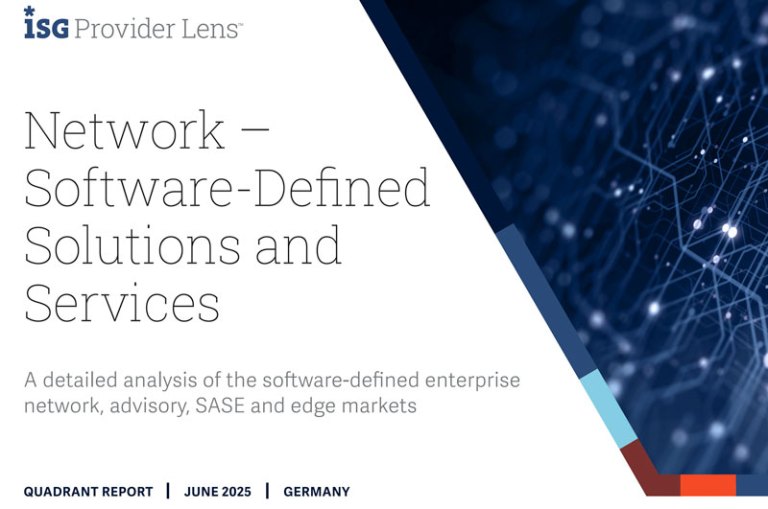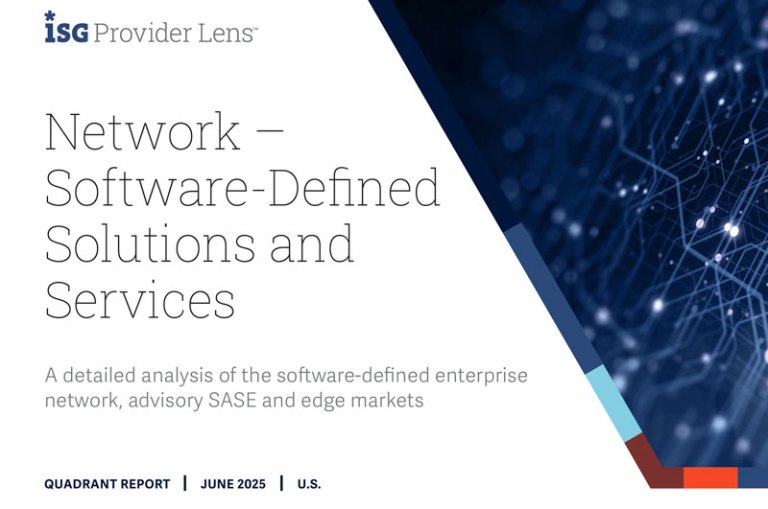Traditional WANs have long supported enterprise connectivity, but as businesses expand across locations, adopt hybrid work, and migrate to the cloud, new demands are reshaping the network.
SD-WAN (Software-Defined Wide Area Network) builds on the foundation of traditional WANs, introducing smarter traffic routing, better visibility, and greater flexibility. It unifies broadband, MPLS, LTE and 5G FWA to enhance performance and simplify operations.
In this blog, we'll break down SD-WAN architecture, deployment models, and the advantages it delivers in performance, security and scalability. Learn how our Managed SD-WAN can help evolve your network with confidence.
Key Components of SD-WAN Architecture
SD-WAN combines hardware and software tools to deliver an optimized, flexible network. Each component plays a specific role in creating a flexible and responsive network environment. Here's a breakdown of the core components:
- Edge Devices: Edge devices—physical routers or virtual appliances—are deployed at branch offices, data centers, or cloud environments to manage network traffic. They direct data across the most efficient paths while securing connections through encrypted tunnels and intrusion detection systems. By managing traffic at the network edge, these devices ensure that all data moves securely and efficiently.
- Cloud-Based Overlay: At the heart of SD-WAN is the cloud-based overlay network. It abstracts the physical infrastructure, creating a virtualized layer that intelligently routes traffic across multiple underlying transport options, such as broadband, LTE or MPLS. This overlay enables centralized policy control, dynamic path selection, and seamless scalability. It also enhances security by segmenting traffic and enforcing consistent policies end-to-end.
- Centralized Controller: The centralized controller acts as the command center for your SD-WAN network. Administrators can manage all devices and policies from a single platform without needing manual configurations at every branch. The controller continuously monitors network performance metrics, like latency and jitter, and dynamically adjusts traffic routes to optimize application performance. This streamlined control reduces complexity and enhances visibility across the entire network.
- Orchestration and Analytics: Orchestration tools simplify network management by automating device configurations, enforcing policies, and enabling features like Zero-Touch Provisioning (ZTP). With real-time analytics, administrators gain insights into network health, traffic patterns, and performance bottlenecks. Centralized orchestration ensures businesses can operate efficiently, scale quickly, and respond proactively to network issues.
Deployment Models of SD-WAN
The right SD-WAN deployment model depends on your organization's infrastructure, size, and IT expertise. Options include:
- On-Premises: On-premises deployments install SD-WAN appliances at physical locations, giving businesses direct control over their network operations. Sensitive data remains on internal servers, which may help meet compliance requirements for industries like healthcare or finance. However, this model often requires more maintenance and management resources.
- Cloud-Enabled: SD-WAN integrates seamlessly with cloud environments, enabling businesses to connect directly to platforms like AWS, Azure, or Google Cloud. By simplifying connectivity, this model allows organizations to streamline network management and enhance cloud application performance.
- Hybrid Models: SD-WAN combines on-premises and cloud-enabled deployments to provide flexibility and scalability. This dual-path approach maximizes bandwidth utilization while adapting to changing business demands and traffic conditions. By combining the best of both worlds, hybrid models deliver agility without sacrificing performance.
Before selecting the deployment model that suits your organization, consider security needs, compliance requirements, as well as budget and scalability.
Types of SD-WAN Architecture Deployment
The SD-WAN architecture deployment mentioned below is relevant to the overall network structure. Select the option that suits the performance needs of your business.
-
- Internet-based SD-WAN (DIY SD-WAN): This low-cost, flexible option uses public internet connections to manage traffic routing. Organizations deploy and maintain appliances internally, offering control without significant upfront investment.
Performance concerns related to long distances may not be an issue for businesses operating in a single region or with access to high-quality internet. Additionally, enterprises with in-house IT expertise can efficiently handle deployment and management, making DIY SD-WAN a viable choice.
- Internet-based SD-WAN (DIY SD-WAN): This low-cost, flexible option uses public internet connections to manage traffic routing. Organizations deploy and maintain appliances internally, offering control without significant upfront investment.
-
- Carrier and MSP Managed Service SD-WAN: With this model, businesses partner with a Managed Service Provider (MSP) or carrier to handle installation, connectivity, and ongoing network management. This approach benefits mid-to-large enterprises looking for expertise, service-level agreements (SLAs) that ensure performance, and a simplified IT burden.
Unlike DIY options, carrier and MSP-managed SD-WAN solutions often leverage a mix of public internet, private links, and cloud onramps to optimize application performance. This model is ideal for organizations that require high network reliability, predictable performance, and expert support without managing infrastructure in-house.
- Carrier and MSP Managed Service SD-WAN: With this model, businesses partner with a Managed Service Provider (MSP) or carrier to handle installation, connectivity, and ongoing network management. This approach benefits mid-to-large enterprises looking for expertise, service-level agreements (SLAs) that ensure performance, and a simplified IT burden.
- SD-WAN as-a-Service (Cloud-First WAN): Like a cloud service, SD-WAN as-a-Service, or Cloud-First WAN, functions by merging the security and reliability of private networks with the flexibility of internet-based connectivity. This model leverages a private core network, which enhances speed and overall WAN performance without requiring significant infrastructure investments.
With optimized connectivity across a global private backbone, this solution is ideal for businesses seeking rapid scalability, secure cloud access, and simplified management. Whether expanding to new locations or optimizing global operations, SD-WAN as-a-Service ensures seamless connectivity with minimal effort.
Each deployment type influences how you implement SD-WAN within your network architecture, impacting factors such as control, scalability, performance, and management responsibilities.
Benefits of SD-WAN Architecture for Large Enterprises
Large organizations are moving towards a centralized network management system and transitioning from traditional wide-area networks to SD-WAN. The shift has many benefits, including cost efficiency and enhanced connectivity. Hence, SD-WAN revenues may grow to $42,606 million by 2030.
Enhanced Network Performance and Reliability
SD-WAN intelligently routes traffic across the best-performing paths based on real-time network conditions like latency, jitter, and packet loss. Critical applications like video conferencing or cloud-based tools receive priority bandwidth to ensure smooth performance.
If a path becomes congested, SD-WAN automatically redirects traffic, minimizing downtime and improving reliability. By optimizing connectivity, enterprises can keep operations running smoothly, even during network disruptions.
Improved Security Posture
SD-WAN integrates built-in security features like encryption, firewalls, and intrusion prevention systems to protect data as it travels across the network. Communications between branches, data centers, and cloud platforms are automatically secured without manual configurations.
This streamlined approach reduces vulnerabilities, ensures compliance, and strengthens defenses against evolving cyber threats.
Cost Efficiency and Scalability
By reducing reliance on costly MPLS connections, SD-WAN enables businesses to leverage more affordable broadband or LTE options. Dynamic traffic optimization minimizes bandwidth waste while lowering operational expenses.
SD-WAN's scalability also supports rapid branch deployments and the addition of new devices without complex reconfigurations. Growing enterprises can adapt quickly to changing demands without increasing network costs.
Support for Digital Transformation Initiatives
SD-WAN accelerates digital transformation by ensuring seamless integration with cloud applications, remote work tools, and emerging technologies. SD-WAN supports multiple transport methods and reliable access to company resources from anywhere.
This level of agility empowers businesses to adopt new solutions and expand their digital capabilities without sacrificing performance or security.
Considerations for Implementing SD-WAN
When adopting SD-WAN, you should evaluate several factors to ensure the solution aligns with your operational needs and goals:
Assessing Network Requirements
Evaluate your current infrastructure, including connections (MPLS, broadband, LTE, 5G FWA) and hardware. Understanding these components ensures that SD-WAN integrates seamlessly with existing systems while enhancing performance.
Security Integration
Combining SD-WAN with Secure Access Service Edge (SASE) creates a unified solution that supports secure, agile, and scalable networking. SD-WAN provides intelligent routing and performance optimization, while SASE integrates key security capabilities like Secure Web Gateway (SWG) and Cloud Access Security Broker (CASB) into a cloud-delivered framework.
Zero Trust Network Access (ZTNA) enhances this framework by adding identity-based access controls. ZTNA works alongside SASE to ensure users and devices are continuously verified before accessing critical applications and data, no matter where they are.
With centralized control through the GTT Envision platform, GTT helps organizations enforce consistent policies, gain full visibility, and defend against threats across their digital environments. Together, SD-WAN and SASE form the backbone.
Planning for Integration and Migration
Integrating SD-WAN into existing networks requires a strategic approach that includes phased deployment, staff training, and awareness of potential challenges. A phased deployment allows you to implement SD-WAN, starting with pilot sites to test configurations and performance before a broader rollout.
This method reduces risk and enables teams to refine processes based on initial feedback. Staff training ensures that IT personnel are equipped to manage the new technology effectively; this includes understanding SD-WAN's features, monitoring tools, and security protocols.
During the transition, you should anticipate challenges such as interoperability issues with legacy systems, potential disruptions during the cutover process, and the need for ongoing support as users adapt to the new network environment.
Take the Next Steps with SD-WAN Architecture and GTT
Modern enterprises need networks that are secure, scalable and reliable. SD-WAN delivers all this and more-simplifying operations, optimizing cloud connectivity and reducing costs.
At GTT, we combine Managed SD-WAN with advanced cybersecurity solutions to help businesses stay connected and protected. Whether you need secure cloud integration, DDoS protection and mitigation, or 24/7 network monitoring, Managed Detection and Response (MDR), our experts are ready to deliver.
Talk to our experts today about getting a more reliable and accessible network.










